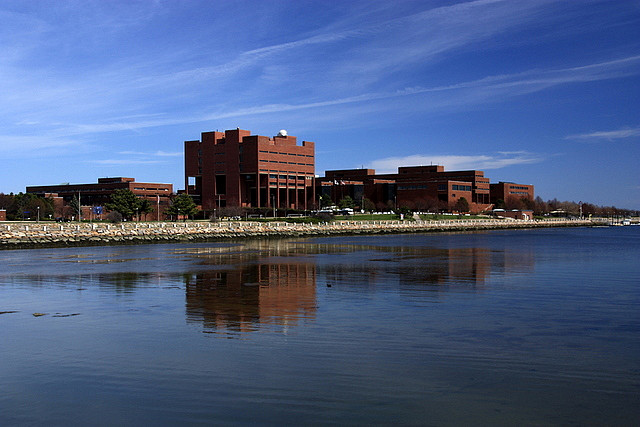
The Search for a New Campus
The University of Massachusetts-Boston (UMB) formally came into existence in 1964, and soon after began a search for a suitable location for a permanent campus. It was the state and university president’s hope that a new campus would enable UMass-Boston to compete and offer a more affordable alternative to the numerous private universities in the Boston area. At the time, UMass-Boston was operating in downtown Boston, but wanted to grow out and transform from a mostly commuter school to “20, 25, 35,000 students.”1 In October 1968, Columbia Point was formally chosen as the land that UMass-Boston would call home, a decision that sparked immediate discontent from both UMass-Boston faculty and students, as well as Columbia Point residents. But the campaign was intense and brief.
The search for a new campus had begun soon after UMB’s conception. UMB’s vision of itself was very clear: it was going to be a university of the 21st century which would be able to “set itself from the start in the maelstrom of contemporary life, drawing on the resources of the city, contributing to the richness of the city.”2 With this, UMass-Boston made it clear that it wanted to “add to, not subtract from, the city of Boston.”3 The intention was for UMass-Boston to be a university for those who otherwise might rule out college, especially lower income residents of Boston. Moreover, UMass-Boston proposed a “mutually enriching development through joint planning, joint construction, joint occupancy of space with commercial and retail interests, public agencies, local community projects, or any combination of these.”4
In 1967, the Boston Redevelopment Authority (BRA) issued a report for the University of Massachusetts-Boston titled “Campus By the Sea, '' which proposed the concept of an urban university on the shore.5 In the introduction of this report, one of the main reasons for the location of the campus on Columbia Point was to “utilize one of Boston’s few remaining areas of vacant land.”6 At the time, there were 130 acres of already developed land, and the BRA proposed that UMass-Boston occupy another 112 acres - almost half of the total land at Columbia Point. It was cheaper and was ripe for development. Furthermore, the issue of isolation that plagued the tenants of the Columbia Point housing project was posed for immediate resolution by the proposed opening of a “new MBTA station on the Harvard-Ashmont and South Shore transit lines.”7 The extension of the subway line was in fact designed to mollify faculty and students that had been against the Columbia Point location, saying that it was “physically and psychologically isolated.”8
Notwithstanding the commitments by the BRA to sway UMass-Boston to choose the Columbia Point campus, the most decisive factor for Columbia Point was the immense financial savings. UMB’s campus at South Station had a projected cost of \$416 million, while a Copley campus had a projected cost of \$389 million. In comparison, a Columbia Point campus would cost only \$266 million, with significantly lower costs in demolition and site acquisition.9
On November 22, 1968, the Board of Trustees held the official vote on the destination of UMB’s new campus. UMass-Boston had long only been considering three sites, but Ed Logue and the BRA had been campaigning for a “campus by the sea” with relocation to Columbia Point.10 After “discussion with faculty, students, and consultants,” the Trustees affirmed the decision to move to Columbia Point.11 The vote, despite being 14-4 in favor of Columbia Point, still faced “heavy opposition from the UMass-Boston chancellor, faculty and students, university alumni, Cardinal Cushing, and several legislators.”12 The conflict between the BRA and people with ties to UMass-Boston, though, was not enough to hinder a vote in favor of Columbia Point. The trustees and the chancellor, Francis Broderick, were at odds, and Broderick even recommended delaying the vote for two months. Instead, the trustees carried on with the vote.13